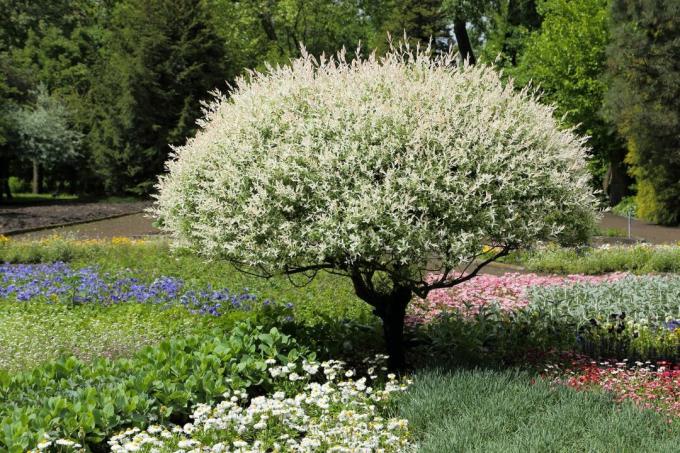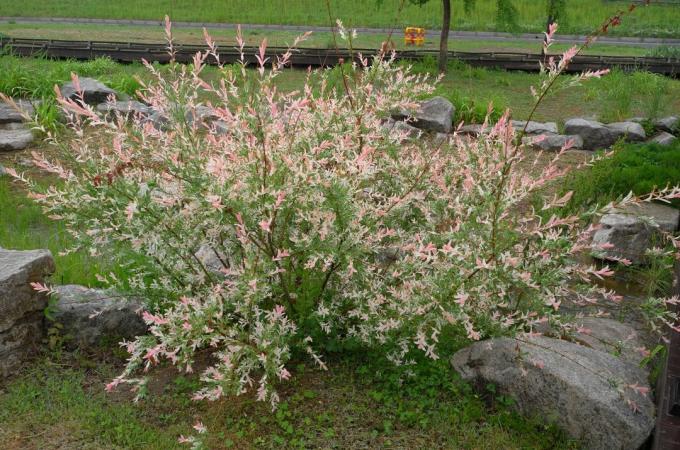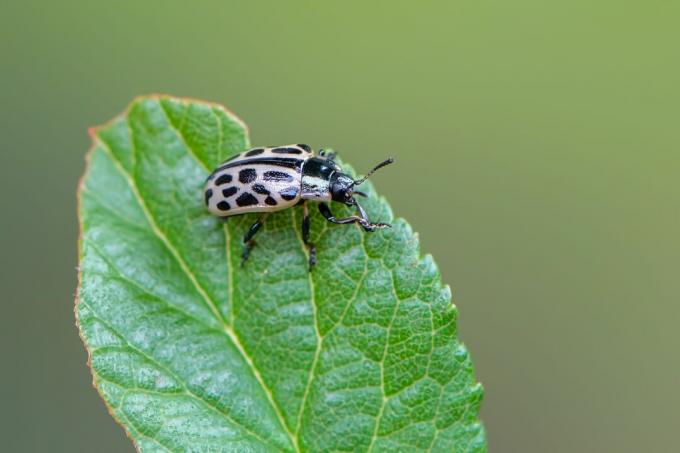With its colorful foliage, the harlequin willow attracts everyone's attention. The East Asian willow flowers only rarely, but the real attraction is the colorful leaf shoots in spring.

Not only with its easy-care handling brings the harlequin willow (Salix integra) every gardener joy. Also thanks to its white-pink foliage, which changes over the course of the year, it is a real eye-catcher in every garden. Here you can find out what a suitable location looks like and what you should consider when caring for it.
contents
- Harlequin willow: size, flowering and characteristics
- Planting harlequin willow: location, timing and procedure
- Maintain harlequin pasture
- Propagate harlequin willow
- Harlequin willow overwinter
- Common pests and diseases of harlequin willow
- Is the harlequin willow poisonous?
Harlequin willow: size, flowering and characteristics
The Harlequin Willow (Salix integra ‘Hakuro Nishiki’), or Japanese ornamental willow, is also called variegated willow or flamingo tree because of its particularly beautiful, white-pink variegated foliage. It belongs to the willow family (
Salicaceae).It originally comes from East Asia and is widespread throughout Japan, Korea and northern China. The harlequin willow is particularly popular as a shrub or standard. The ornamental willow can reach a height of up to 3 meters and an average width of 1.5 meters. Between March and April the harlequin willow has flowering time. The inconspicuous yellow catkins appear before the leaves and provide plenty of food for insects early in the year. The sprouting of the new leaves is often confused with the actual blossom. The oblong leaves arranged opposite on the red young shoots are initially white and pink patterned. That's why they look like colorful flowers in front of the green-white discolored shoots. This effect is particularly beautiful when the harlequin willow is in the sun. The frost-hardy, deciduous plant develops flat roots, which is why it can also be kept well in a bucket.

Tip: When cultivated as a standard tree, it is grafted onto the trunk of another willow species so that it reaches an optimal trunk height. The trunk of the harlequin willow is already fully grown when you buy it and is available in different sizes.
Planting harlequin willow: location, timing and procedure
In order to be able to admire the unusual play of colors of the leaves, you should look for a location in the sun for the harlequin willow. A semi-shady place is also suitable, but it should not be completely shady. Like all willows, it prefers loose, humus-rich, moist and cool soil and can also be planted in pots because of its shallow roots. The vessel should be large and glazed so that the soil cannot dry out so quickly. A loose and high-quality potting soil like ours is suitable as a substrate Plantura organic universal soil. It can be used in the pot or mixed into sandy garden soil. The pasture benefits from the compost it contains and the soil in the bed also promotes healthy soil life.
The best time to plant the harlequin willow is in the fall or spring. This way the roots are not directly exposed to the summer drought. After planting, the harlequin willow should be watered abundantly. If you want to plant the harlequin willow as a high trunk, it is best to tie the trunk in a permanently stable manner so that the trunk does not tear in strong winds.
Tip: Those for whom a pink willow in the garden is not enough can also cultivate the willow as a hedge. A planting distance of 50 - 60 cm should be maintained so that the roots have enough space to grow. The fast-growing willow hedge is up to 1.5 m high and with regular pruning you can enjoy the colorful shoots every year.
Maintain harlequin pasture
The harlequin willow is considered an extremely easy-care plant. Nevertheless, it needs occasional water and fertilizer as well as a pruning so that it continues to present its foliage.
At the cutting willows there are a few things to consider. The best time to cut back is in spring. But if you want to keep the flower for insects, you should cut back a little later, after the flowering period in April.
And this is how you proceed when you cut your harlequin willow:
- Remove shoots from the stem
- Cut dead, crossing and diseased branches at the base
- Shorten all shoots by two thirds
- Always cut above a bud
- Harlequin willow shrubs can also be pruned radically in the fall so that only a few stubs remain
- Do not injure grafting points on tall stems
- Prune if necessary in summer

tip: Willows sprout again very quickly and can therefore be severely cut back. Most of the colorful leaves are on the young, newly sprouting shoots.
The substrate of the harlequin willow dries up relatively quickly, especially in pots and tubs. You should preferably water the willow so that the soil is moist but not waterlogged, as this is very damaging to the roots. Especially in midsummer, it is advisable to regularly check whether the soil is still moist. Otherwise it should be refilled with rainwater or lime-free water.
Potted plants also benefit from annual fertilization in spring around the time the leaves sprout. A complete fertilizer like ours Plantura organic universal fertilizerright lasts a long time and supplies the harlequin willow with sufficient nutrients for a long time. Our biological fertilizer is primarily organic and safe for pets and garden animals.

Harlequin willows in tubs also need a new planter from time to time because they form a large root ball and need more space. The fresh substrate is also conducive to growth. If the root ball grows out of the pot or the harlequin willow is no longer growing properly, it is time for a new pot. It is best to repot in the fall. Be careful not to damage roots. You can also replant the harlequin willow and place it in a more suitable location in the garden if necessary. When repotting, nutrient-rich, slightly acidic potting soil and a well-balanced complete fertilizer like ours are used again Plantura organic universal fertilizer for use. The latter works for several months and constantly releases all the essential nutrients.
Propagate harlequin willow
The propagation of the harlequin willow and many other willow species is basically very simple. You can use offshoots or cuttings to propagate the harlequin willow. To create an offshoot yourself, bend a branch of the shrub so that it rests on the ground. Secure the branch with a rock or metal peg, pile some soil in the middle of the branch and keep it moist. If the offshoot has formed many roots after a year at the latest, it can be separated from the mother plant. This creates a shrub-like harlequin willow.
Propagating cuttings is just as easy. The best way to do this is to place the branches cut off after pruning in a vase of water and wait for roots to form. The rooted young willows should then first be planted in a pot with a soil-sand mixture before they are planted out.

If you want to cultivate a harlequin willow as a standard, you have to graft the branch onto a previously grown willow trunk. However, this requires some practice and unfortunately the refinement does not always succeed. The appropriate technique is winter hand finishing. For this purpose, young shoots of the harlequin willow are cut off in autumn and grafted onto the base by means of split grafting. Suitable rootstocks are, for example, wicker (Salix viminalis) or ripe willow (Salix daphnoids). These can be shortened to the desired height directly before grafting - this determines the height of the willow trunk. A gap of about 4 cm in length is cut into the cutting site with a sharp knife. Now you need a shoot of the harlequin willow, which is grafted onto the base. It should have the same diameter as the base, otherwise it will be difficult to grow together. The lower end is now cut like a wedge that fits exactly into the gap in the underlay. The scion is stuck firmly into the pad and wrapped tightly with raffia to secure it. The interfaces are then coated with tree wax. It is best to place the plant in an evenly warm and bright place.
Harlequin willow overwinter
If you have decided to plant the harlequin willow in a bucket, you must also protect it in winter. It is therefore advantageous to wrap the pot in bubble wrap, fleece or a jute sack. Then put the willow in a wind-protected place.
Harlequin willows planted in established soil require no more than a layer of mulch over the garden soil to protect against permafrost. Otherwise the willow is considered hardy and generally overwinters without problems.

Common pests and diseases of harlequin willow
The harlequin willow is rather insensitive to pests and diseases, but there are a few exceptions:
- Brown leaf tips: If the harlequin willow gets brown leaf tips, this is usually due to too much or too little water. In this case, check the soil and adjust the watering.
- willow borer (Cossus cossus): If the harlequin willow is infested with pests, it is often the willow borer. Its larvae are easy to recognize because they are white to dark red and live in the wood where they are clearly visible. As a symptom, the leaves of the willow usually curl. You should cut off the affected branches generously and burn them, as the willow borer lives on in the dead wood and can reinfect the plant after pupating.
- Spotted willow leaf beetle (Chrysomela vigintipunctata): If your pasture shows signs of being eaten, it may be the spotted willow leaf beetle, which you can also fight by cutting back the branches.
- fungal attack: A fungal attack with rust fungi or anthracnose is characterized by black-brown spots on leaves and branches. They appear burnt and need to be pruned generously.

Is the harlequin willow poisonous?
Basically, the harlequin willow is not considered poisonous. However, bark and shoots contain tannins that are released if a dog or cat chews on them for a long time. These tannins can then lead to indigestion. With less conspicuous foliage, but with spectacular flowers in spring, the Judas tree. We give tips and tricks on location and care.
